Strategies in International Hotels
VerifiedAdded on 2023/06/10
|8
|2144
|390
AI Summary
This paper compares and contrasts the strategic approaches of two Asian multinational hotel groups, Shangri-La Hotels and Banyan Tree Holdings, and analyses the differences between their strategies and the role these strategies played in their success. It also suggests strategies for Shangri-La to establish itself in Birmingham, UK. The paper discusses the differences in leadership style, employee decision making capability, cultural intelligence, and human resource strategies between the two hotel groups.
Contribute Materials
Your contribution can guide someone’s learning journey. Share your
documents today.
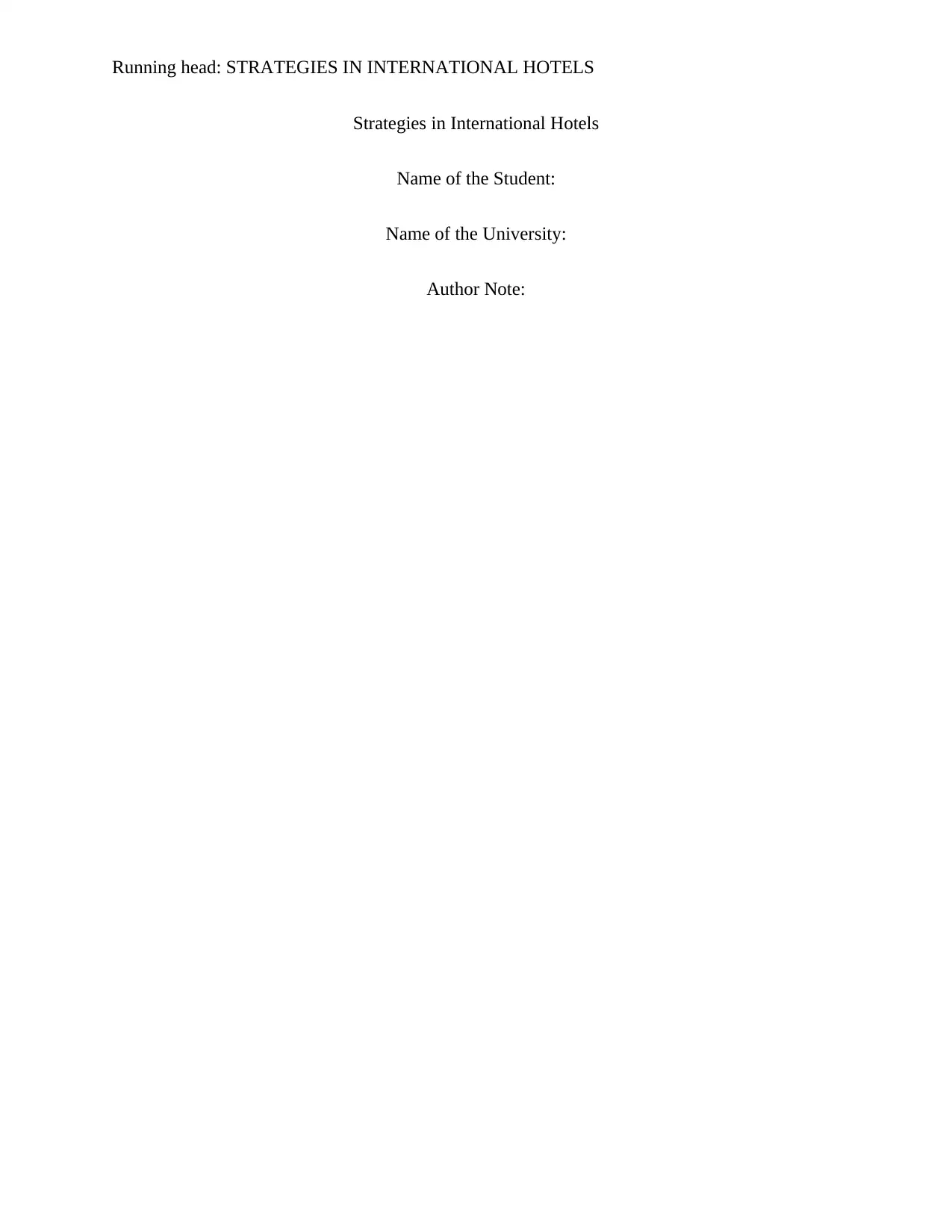
Running head: STRATEGIES IN INTERNATIONAL HOTELS
Strategies in International Hotels
Name of the Student:
Name of the University:
Author Note:
Strategies in International Hotels
Name of the Student:
Name of the University:
Author Note:
Secure Best Marks with AI Grader
Need help grading? Try our AI Grader for instant feedback on your assignments.
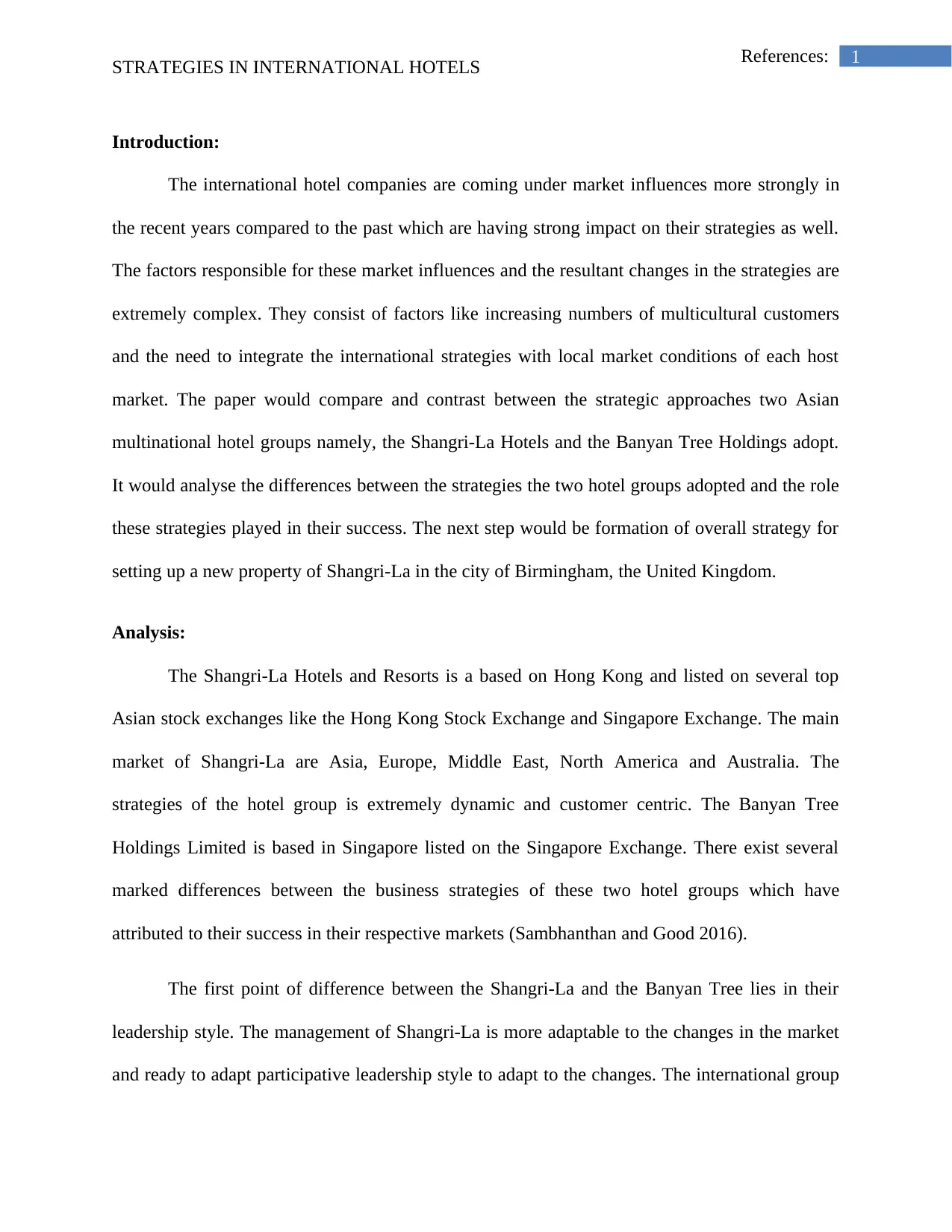
1References:
STRATEGIES IN INTERNATIONAL HOTELS
Introduction:
The international hotel companies are coming under market influences more strongly in
the recent years compared to the past which are having strong impact on their strategies as well.
The factors responsible for these market influences and the resultant changes in the strategies are
extremely complex. They consist of factors like increasing numbers of multicultural customers
and the need to integrate the international strategies with local market conditions of each host
market. The paper would compare and contrast between the strategic approaches two Asian
multinational hotel groups namely, the Shangri-La Hotels and the Banyan Tree Holdings adopt.
It would analyse the differences between the strategies the two hotel groups adopted and the role
these strategies played in their success. The next step would be formation of overall strategy for
setting up a new property of Shangri-La in the city of Birmingham, the United Kingdom.
Analysis:
The Shangri-La Hotels and Resorts is a based on Hong Kong and listed on several top
Asian stock exchanges like the Hong Kong Stock Exchange and Singapore Exchange. The main
market of Shangri-La are Asia, Europe, Middle East, North America and Australia. The
strategies of the hotel group is extremely dynamic and customer centric. The Banyan Tree
Holdings Limited is based in Singapore listed on the Singapore Exchange. There exist several
marked differences between the business strategies of these two hotel groups which have
attributed to their success in their respective markets (Sambhanthan and Good 2016).
The first point of difference between the Shangri-La and the Banyan Tree lies in their
leadership style. The management of Shangri-La is more adaptable to the changes in the market
and ready to adapt participative leadership style to adapt to the changes. The international group
STRATEGIES IN INTERNATIONAL HOTELS
Introduction:
The international hotel companies are coming under market influences more strongly in
the recent years compared to the past which are having strong impact on their strategies as well.
The factors responsible for these market influences and the resultant changes in the strategies are
extremely complex. They consist of factors like increasing numbers of multicultural customers
and the need to integrate the international strategies with local market conditions of each host
market. The paper would compare and contrast between the strategic approaches two Asian
multinational hotel groups namely, the Shangri-La Hotels and the Banyan Tree Holdings adopt.
It would analyse the differences between the strategies the two hotel groups adopted and the role
these strategies played in their success. The next step would be formation of overall strategy for
setting up a new property of Shangri-La in the city of Birmingham, the United Kingdom.
Analysis:
The Shangri-La Hotels and Resorts is a based on Hong Kong and listed on several top
Asian stock exchanges like the Hong Kong Stock Exchange and Singapore Exchange. The main
market of Shangri-La are Asia, Europe, Middle East, North America and Australia. The
strategies of the hotel group is extremely dynamic and customer centric. The Banyan Tree
Holdings Limited is based in Singapore listed on the Singapore Exchange. There exist several
marked differences between the business strategies of these two hotel groups which have
attributed to their success in their respective markets (Sambhanthan and Good 2016).
The first point of difference between the Shangri-La and the Banyan Tree lies in their
leadership style. The management of Shangri-La is more adaptable to the changes in the market
and ready to adapt participative leadership style to adapt to the changes. The international group
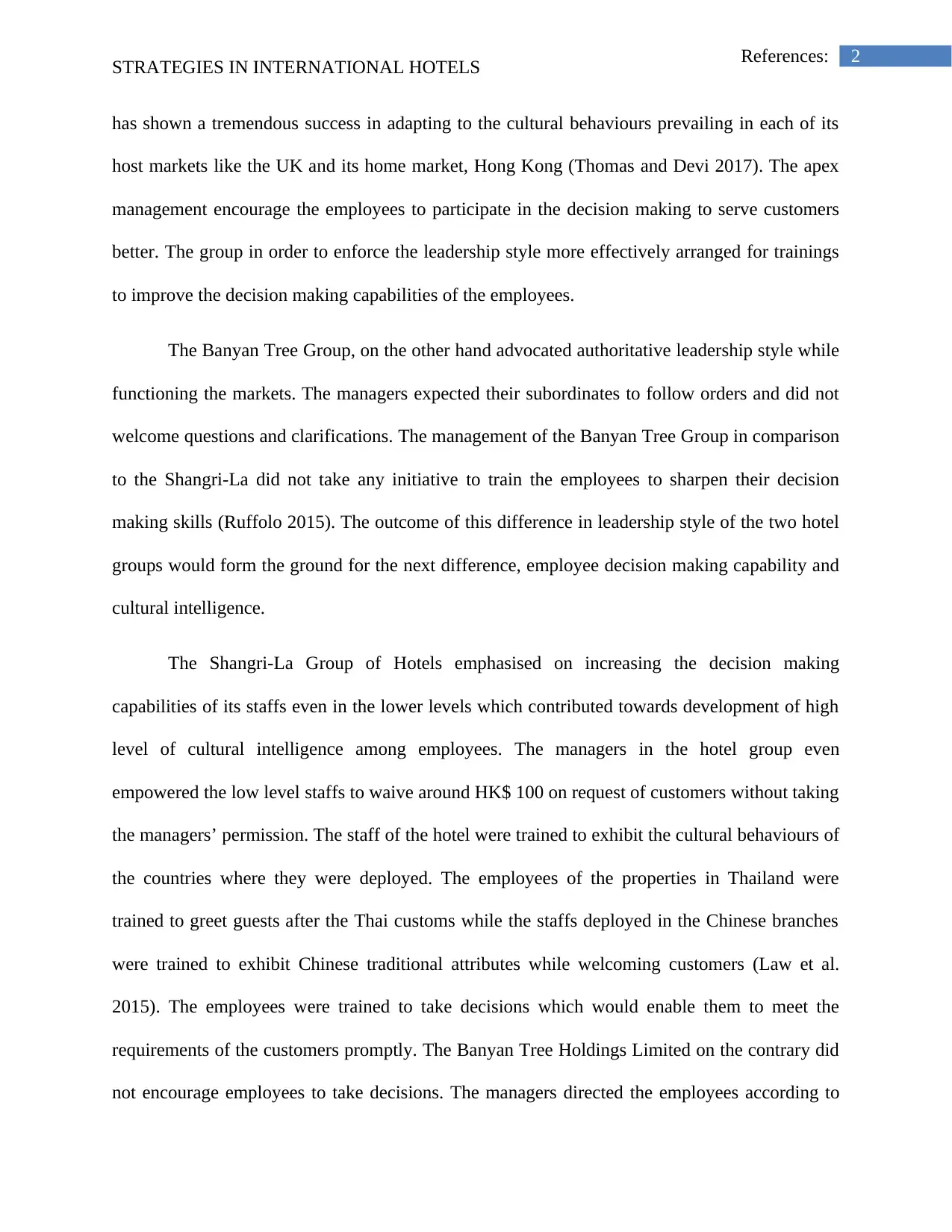
2References:
STRATEGIES IN INTERNATIONAL HOTELS
has shown a tremendous success in adapting to the cultural behaviours prevailing in each of its
host markets like the UK and its home market, Hong Kong (Thomas and Devi 2017). The apex
management encourage the employees to participate in the decision making to serve customers
better. The group in order to enforce the leadership style more effectively arranged for trainings
to improve the decision making capabilities of the employees.
The Banyan Tree Group, on the other hand advocated authoritative leadership style while
functioning the markets. The managers expected their subordinates to follow orders and did not
welcome questions and clarifications. The management of the Banyan Tree Group in comparison
to the Shangri-La did not take any initiative to train the employees to sharpen their decision
making skills (Ruffolo 2015). The outcome of this difference in leadership style of the two hotel
groups would form the ground for the next difference, employee decision making capability and
cultural intelligence.
The Shangri-La Group of Hotels emphasised on increasing the decision making
capabilities of its staffs even in the lower levels which contributed towards development of high
level of cultural intelligence among employees. The managers in the hotel group even
empowered the low level staffs to waive around HK$ 100 on request of customers without taking
the managers’ permission. The staff of the hotel were trained to exhibit the cultural behaviours of
the countries where they were deployed. The employees of the properties in Thailand were
trained to greet guests after the Thai customs while the staffs deployed in the Chinese branches
were trained to exhibit Chinese traditional attributes while welcoming customers (Law et al.
2015). The employees were trained to take decisions which would enable them to meet the
requirements of the customers promptly. The Banyan Tree Holdings Limited on the contrary did
not encourage employees to take decisions. The managers directed the employees according to
STRATEGIES IN INTERNATIONAL HOTELS
has shown a tremendous success in adapting to the cultural behaviours prevailing in each of its
host markets like the UK and its home market, Hong Kong (Thomas and Devi 2017). The apex
management encourage the employees to participate in the decision making to serve customers
better. The group in order to enforce the leadership style more effectively arranged for trainings
to improve the decision making capabilities of the employees.
The Banyan Tree Group, on the other hand advocated authoritative leadership style while
functioning the markets. The managers expected their subordinates to follow orders and did not
welcome questions and clarifications. The management of the Banyan Tree Group in comparison
to the Shangri-La did not take any initiative to train the employees to sharpen their decision
making skills (Ruffolo 2015). The outcome of this difference in leadership style of the two hotel
groups would form the ground for the next difference, employee decision making capability and
cultural intelligence.
The Shangri-La Group of Hotels emphasised on increasing the decision making
capabilities of its staffs even in the lower levels which contributed towards development of high
level of cultural intelligence among employees. The managers in the hotel group even
empowered the low level staffs to waive around HK$ 100 on request of customers without taking
the managers’ permission. The staff of the hotel were trained to exhibit the cultural behaviours of
the countries where they were deployed. The employees of the properties in Thailand were
trained to greet guests after the Thai customs while the staffs deployed in the Chinese branches
were trained to exhibit Chinese traditional attributes while welcoming customers (Law et al.
2015). The employees were trained to take decisions which would enable them to meet the
requirements of the customers promptly. The Banyan Tree Holdings Limited on the contrary did
not encourage employees to take decisions. The managers directed the employees according to
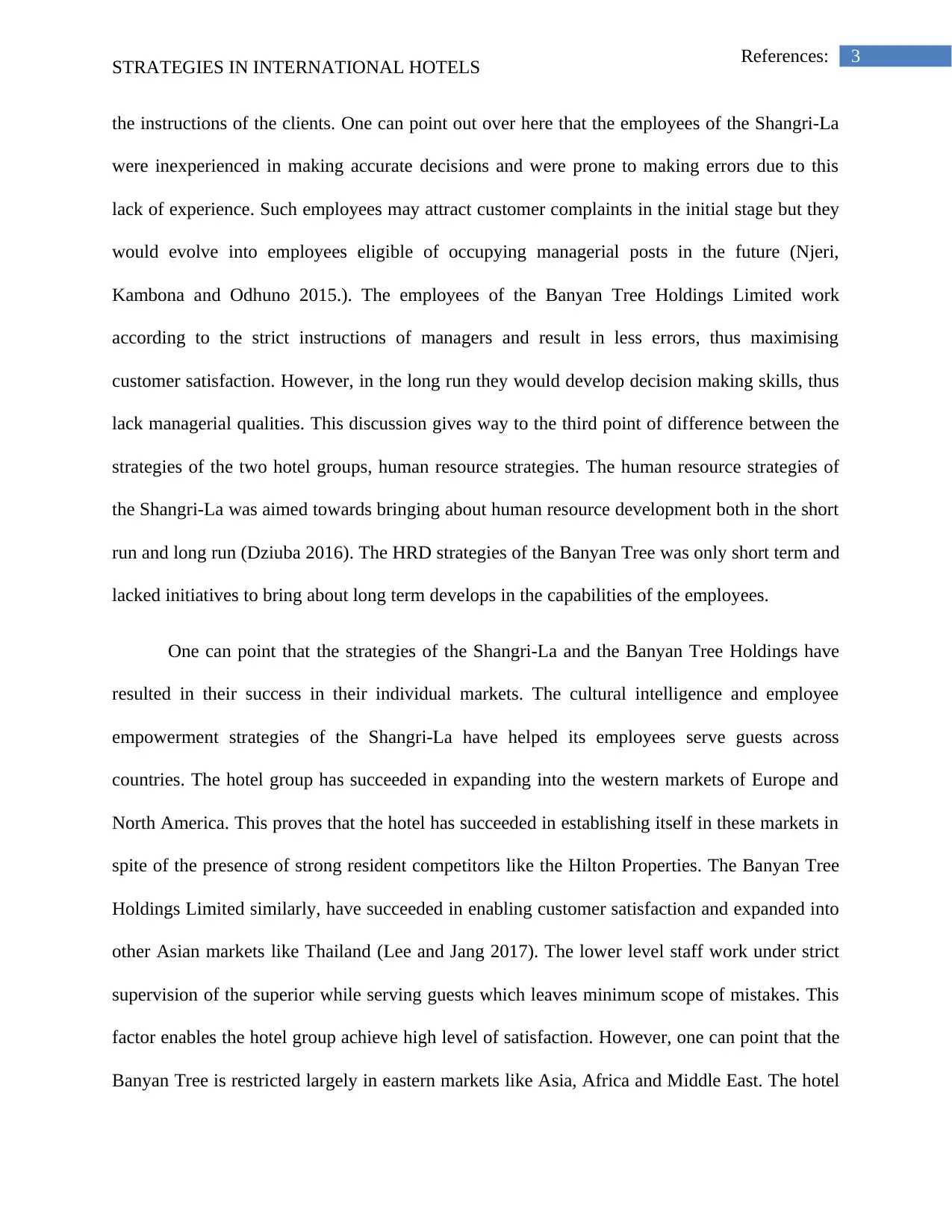
3References:
STRATEGIES IN INTERNATIONAL HOTELS
the instructions of the clients. One can point out over here that the employees of the Shangri-La
were inexperienced in making accurate decisions and were prone to making errors due to this
lack of experience. Such employees may attract customer complaints in the initial stage but they
would evolve into employees eligible of occupying managerial posts in the future (Njeri,
Kambona and Odhuno 2015.). The employees of the Banyan Tree Holdings Limited work
according to the strict instructions of managers and result in less errors, thus maximising
customer satisfaction. However, in the long run they would develop decision making skills, thus
lack managerial qualities. This discussion gives way to the third point of difference between the
strategies of the two hotel groups, human resource strategies. The human resource strategies of
the Shangri-La was aimed towards bringing about human resource development both in the short
run and long run (Dziuba 2016). The HRD strategies of the Banyan Tree was only short term and
lacked initiatives to bring about long term develops in the capabilities of the employees.
One can point that the strategies of the Shangri-La and the Banyan Tree Holdings have
resulted in their success in their individual markets. The cultural intelligence and employee
empowerment strategies of the Shangri-La have helped its employees serve guests across
countries. The hotel group has succeeded in expanding into the western markets of Europe and
North America. This proves that the hotel has succeeded in establishing itself in these markets in
spite of the presence of strong resident competitors like the Hilton Properties. The Banyan Tree
Holdings Limited similarly, have succeeded in enabling customer satisfaction and expanded into
other Asian markets like Thailand (Lee and Jang 2017). The lower level staff work under strict
supervision of the superior while serving guests which leaves minimum scope of mistakes. This
factor enables the hotel group achieve high level of satisfaction. However, one can point that the
Banyan Tree is restricted largely in eastern markets like Asia, Africa and Middle East. The hotel
STRATEGIES IN INTERNATIONAL HOTELS
the instructions of the clients. One can point out over here that the employees of the Shangri-La
were inexperienced in making accurate decisions and were prone to making errors due to this
lack of experience. Such employees may attract customer complaints in the initial stage but they
would evolve into employees eligible of occupying managerial posts in the future (Njeri,
Kambona and Odhuno 2015.). The employees of the Banyan Tree Holdings Limited work
according to the strict instructions of managers and result in less errors, thus maximising
customer satisfaction. However, in the long run they would develop decision making skills, thus
lack managerial qualities. This discussion gives way to the third point of difference between the
strategies of the two hotel groups, human resource strategies. The human resource strategies of
the Shangri-La was aimed towards bringing about human resource development both in the short
run and long run (Dziuba 2016). The HRD strategies of the Banyan Tree was only short term and
lacked initiatives to bring about long term develops in the capabilities of the employees.
One can point that the strategies of the Shangri-La and the Banyan Tree Holdings have
resulted in their success in their individual markets. The cultural intelligence and employee
empowerment strategies of the Shangri-La have helped its employees serve guests across
countries. The hotel group has succeeded in expanding into the western markets of Europe and
North America. This proves that the hotel has succeeded in establishing itself in these markets in
spite of the presence of strong resident competitors like the Hilton Properties. The Banyan Tree
Holdings Limited similarly, have succeeded in enabling customer satisfaction and expanded into
other Asian markets like Thailand (Lee and Jang 2017). The lower level staff work under strict
supervision of the superior while serving guests which leaves minimum scope of mistakes. This
factor enables the hotel group achieve high level of satisfaction. However, one can point that the
Banyan Tree is restricted largely in eastern markets like Asia, Africa and Middle East. The hotel
Secure Best Marks with AI Grader
Need help grading? Try our AI Grader for instant feedback on your assignments.
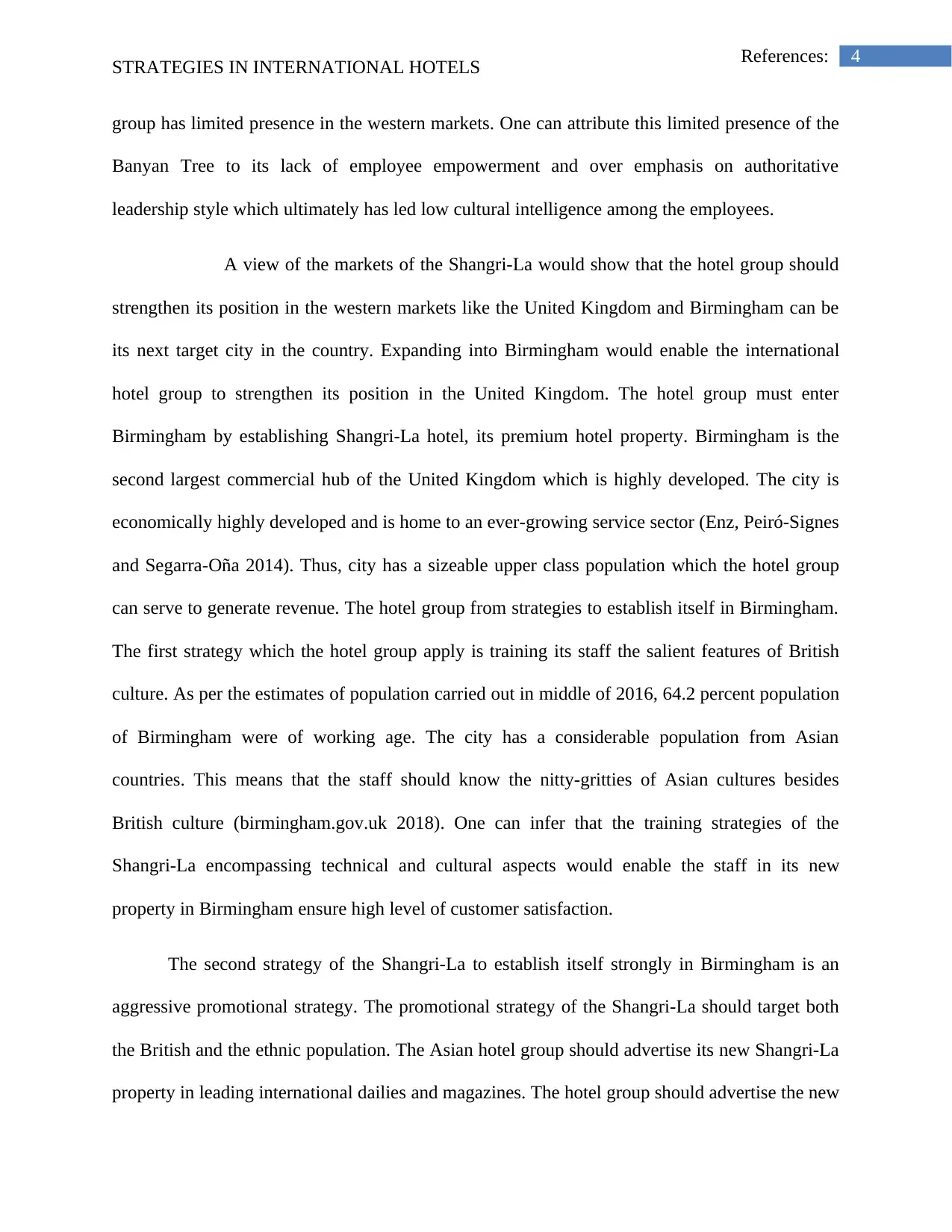
4References:
STRATEGIES IN INTERNATIONAL HOTELS
group has limited presence in the western markets. One can attribute this limited presence of the
Banyan Tree to its lack of employee empowerment and over emphasis on authoritative
leadership style which ultimately has led low cultural intelligence among the employees.
A view of the markets of the Shangri-La would show that the hotel group should
strengthen its position in the western markets like the United Kingdom and Birmingham can be
its next target city in the country. Expanding into Birmingham would enable the international
hotel group to strengthen its position in the United Kingdom. The hotel group must enter
Birmingham by establishing Shangri-La hotel, its premium hotel property. Birmingham is the
second largest commercial hub of the United Kingdom which is highly developed. The city is
economically highly developed and is home to an ever-growing service sector (Enz, Peiró-Signes
and Segarra-Oña 2014). Thus, city has a sizeable upper class population which the hotel group
can serve to generate revenue. The hotel group from strategies to establish itself in Birmingham.
The first strategy which the hotel group apply is training its staff the salient features of British
culture. As per the estimates of population carried out in middle of 2016, 64.2 percent population
of Birmingham were of working age. The city has a considerable population from Asian
countries. This means that the staff should know the nitty-gritties of Asian cultures besides
British culture (birmingham.gov.uk 2018). One can infer that the training strategies of the
Shangri-La encompassing technical and cultural aspects would enable the staff in its new
property in Birmingham ensure high level of customer satisfaction.
The second strategy of the Shangri-La to establish itself strongly in Birmingham is an
aggressive promotional strategy. The promotional strategy of the Shangri-La should target both
the British and the ethnic population. The Asian hotel group should advertise its new Shangri-La
property in leading international dailies and magazines. The hotel group should advertise the new
STRATEGIES IN INTERNATIONAL HOTELS
group has limited presence in the western markets. One can attribute this limited presence of the
Banyan Tree to its lack of employee empowerment and over emphasis on authoritative
leadership style which ultimately has led low cultural intelligence among the employees.
A view of the markets of the Shangri-La would show that the hotel group should
strengthen its position in the western markets like the United Kingdom and Birmingham can be
its next target city in the country. Expanding into Birmingham would enable the international
hotel group to strengthen its position in the United Kingdom. The hotel group must enter
Birmingham by establishing Shangri-La hotel, its premium hotel property. Birmingham is the
second largest commercial hub of the United Kingdom which is highly developed. The city is
economically highly developed and is home to an ever-growing service sector (Enz, Peiró-Signes
and Segarra-Oña 2014). Thus, city has a sizeable upper class population which the hotel group
can serve to generate revenue. The hotel group from strategies to establish itself in Birmingham.
The first strategy which the hotel group apply is training its staff the salient features of British
culture. As per the estimates of population carried out in middle of 2016, 64.2 percent population
of Birmingham were of working age. The city has a considerable population from Asian
countries. This means that the staff should know the nitty-gritties of Asian cultures besides
British culture (birmingham.gov.uk 2018). One can infer that the training strategies of the
Shangri-La encompassing technical and cultural aspects would enable the staff in its new
property in Birmingham ensure high level of customer satisfaction.
The second strategy of the Shangri-La to establish itself strongly in Birmingham is an
aggressive promotional strategy. The promotional strategy of the Shangri-La should target both
the British and the ethnic population. The Asian hotel group should advertise its new Shangri-La
property in leading international dailies and magazines. The hotel group should advertise the new
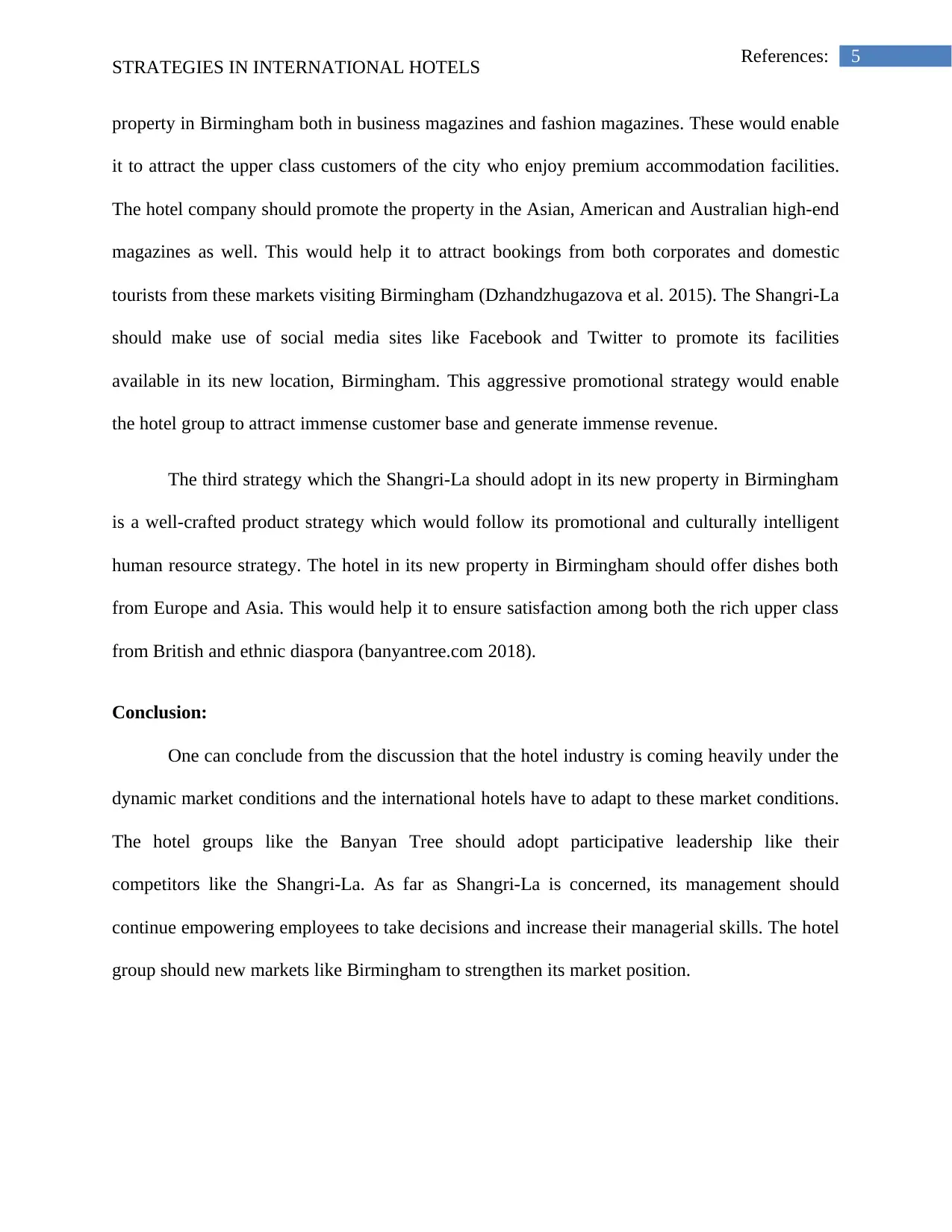
5References:
STRATEGIES IN INTERNATIONAL HOTELS
property in Birmingham both in business magazines and fashion magazines. These would enable
it to attract the upper class customers of the city who enjoy premium accommodation facilities.
The hotel company should promote the property in the Asian, American and Australian high-end
magazines as well. This would help it to attract bookings from both corporates and domestic
tourists from these markets visiting Birmingham (Dzhandzhugazova et al. 2015). The Shangri-La
should make use of social media sites like Facebook and Twitter to promote its facilities
available in its new location, Birmingham. This aggressive promotional strategy would enable
the hotel group to attract immense customer base and generate immense revenue.
The third strategy which the Shangri-La should adopt in its new property in Birmingham
is a well-crafted product strategy which would follow its promotional and culturally intelligent
human resource strategy. The hotel in its new property in Birmingham should offer dishes both
from Europe and Asia. This would help it to ensure satisfaction among both the rich upper class
from British and ethnic diaspora (banyantree.com 2018).
Conclusion:
One can conclude from the discussion that the hotel industry is coming heavily under the
dynamic market conditions and the international hotels have to adapt to these market conditions.
The hotel groups like the Banyan Tree should adopt participative leadership like their
competitors like the Shangri-La. As far as Shangri-La is concerned, its management should
continue empowering employees to take decisions and increase their managerial skills. The hotel
group should new markets like Birmingham to strengthen its market position.
STRATEGIES IN INTERNATIONAL HOTELS
property in Birmingham both in business magazines and fashion magazines. These would enable
it to attract the upper class customers of the city who enjoy premium accommodation facilities.
The hotel company should promote the property in the Asian, American and Australian high-end
magazines as well. This would help it to attract bookings from both corporates and domestic
tourists from these markets visiting Birmingham (Dzhandzhugazova et al. 2015). The Shangri-La
should make use of social media sites like Facebook and Twitter to promote its facilities
available in its new location, Birmingham. This aggressive promotional strategy would enable
the hotel group to attract immense customer base and generate immense revenue.
The third strategy which the Shangri-La should adopt in its new property in Birmingham
is a well-crafted product strategy which would follow its promotional and culturally intelligent
human resource strategy. The hotel in its new property in Birmingham should offer dishes both
from Europe and Asia. This would help it to ensure satisfaction among both the rich upper class
from British and ethnic diaspora (banyantree.com 2018).
Conclusion:
One can conclude from the discussion that the hotel industry is coming heavily under the
dynamic market conditions and the international hotels have to adapt to these market conditions.
The hotel groups like the Banyan Tree should adopt participative leadership like their
competitors like the Shangri-La. As far as Shangri-La is concerned, its management should
continue empowering employees to take decisions and increase their managerial skills. The hotel
group should new markets like Birmingham to strengthen its market position.
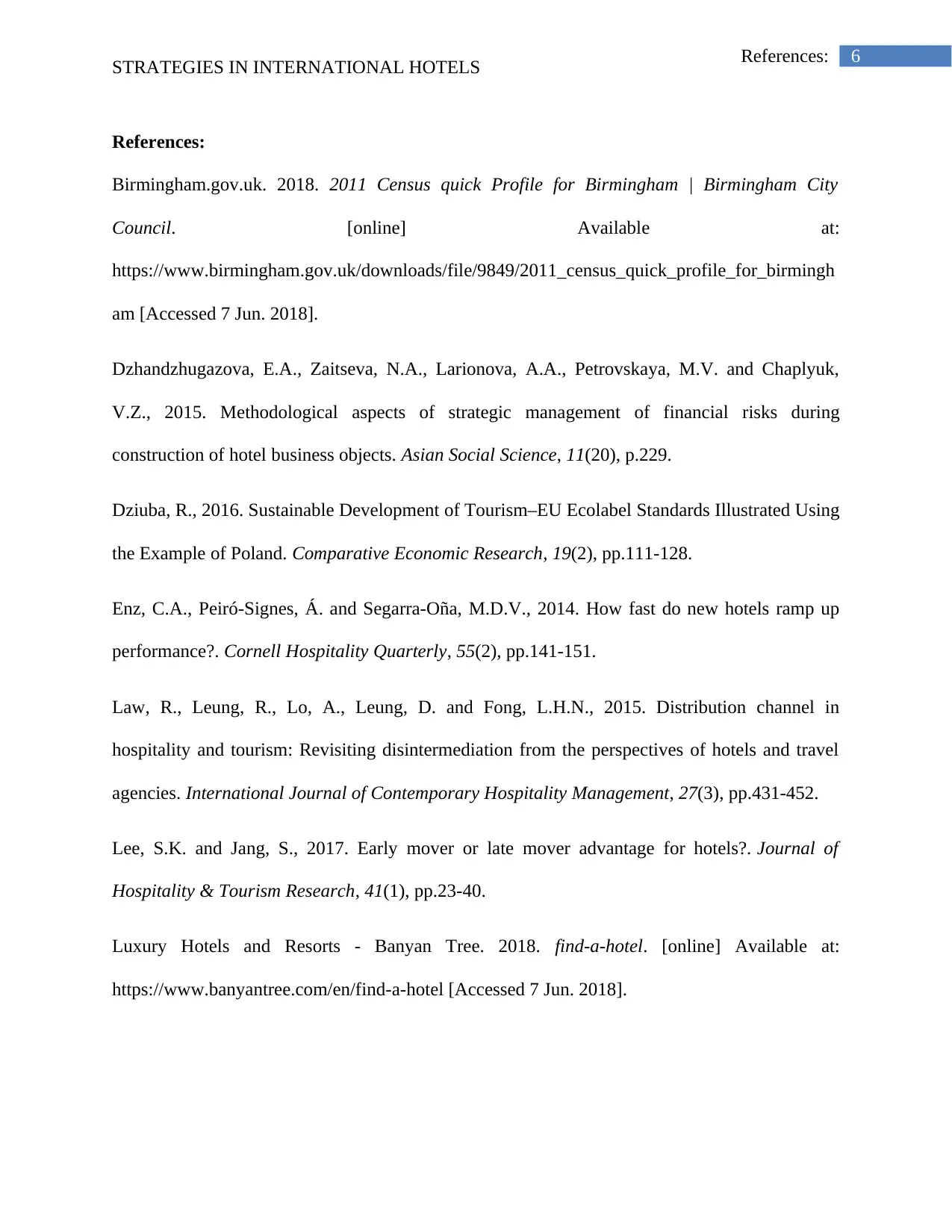
6References:
STRATEGIES IN INTERNATIONAL HOTELS
References:
Birmingham.gov.uk. 2018. 2011 Census quick Profile for Birmingham | Birmingham City
Council. [online] Available at:
https://www.birmingham.gov.uk/downloads/file/9849/2011_census_quick_profile_for_birmingh
am [Accessed 7 Jun. 2018].
Dzhandzhugazova, E.A., Zaitseva, N.A., Larionova, A.A., Petrovskaya, M.V. and Chaplyuk,
V.Z., 2015. Methodological aspects of strategic management of financial risks during
construction of hotel business objects. Asian Social Science, 11(20), p.229.
Dziuba, R., 2016. Sustainable Development of Tourism–EU Ecolabel Standards Illustrated Using
the Example of Poland. Comparative Economic Research, 19(2), pp.111-128.
Enz, C.A., Peiró-Signes, Á. and Segarra-Oña, M.D.V., 2014. How fast do new hotels ramp up
performance?. Cornell Hospitality Quarterly, 55(2), pp.141-151.
Law, R., Leung, R., Lo, A., Leung, D. and Fong, L.H.N., 2015. Distribution channel in
hospitality and tourism: Revisiting disintermediation from the perspectives of hotels and travel
agencies. International Journal of Contemporary Hospitality Management, 27(3), pp.431-452.
Lee, S.K. and Jang, S., 2017. Early mover or late mover advantage for hotels?. Journal of
Hospitality & Tourism Research, 41(1), pp.23-40.
Luxury Hotels and Resorts - Banyan Tree. 2018. find-a-hotel. [online] Available at:
https://www.banyantree.com/en/find-a-hotel [Accessed 7 Jun. 2018].
STRATEGIES IN INTERNATIONAL HOTELS
References:
Birmingham.gov.uk. 2018. 2011 Census quick Profile for Birmingham | Birmingham City
Council. [online] Available at:
https://www.birmingham.gov.uk/downloads/file/9849/2011_census_quick_profile_for_birmingh
am [Accessed 7 Jun. 2018].
Dzhandzhugazova, E.A., Zaitseva, N.A., Larionova, A.A., Petrovskaya, M.V. and Chaplyuk,
V.Z., 2015. Methodological aspects of strategic management of financial risks during
construction of hotel business objects. Asian Social Science, 11(20), p.229.
Dziuba, R., 2016. Sustainable Development of Tourism–EU Ecolabel Standards Illustrated Using
the Example of Poland. Comparative Economic Research, 19(2), pp.111-128.
Enz, C.A., Peiró-Signes, Á. and Segarra-Oña, M.D.V., 2014. How fast do new hotels ramp up
performance?. Cornell Hospitality Quarterly, 55(2), pp.141-151.
Law, R., Leung, R., Lo, A., Leung, D. and Fong, L.H.N., 2015. Distribution channel in
hospitality and tourism: Revisiting disintermediation from the perspectives of hotels and travel
agencies. International Journal of Contemporary Hospitality Management, 27(3), pp.431-452.
Lee, S.K. and Jang, S., 2017. Early mover or late mover advantage for hotels?. Journal of
Hospitality & Tourism Research, 41(1), pp.23-40.
Luxury Hotels and Resorts - Banyan Tree. 2018. find-a-hotel. [online] Available at:
https://www.banyantree.com/en/find-a-hotel [Accessed 7 Jun. 2018].
Paraphrase This Document
Need a fresh take? Get an instant paraphrase of this document with our AI Paraphraser
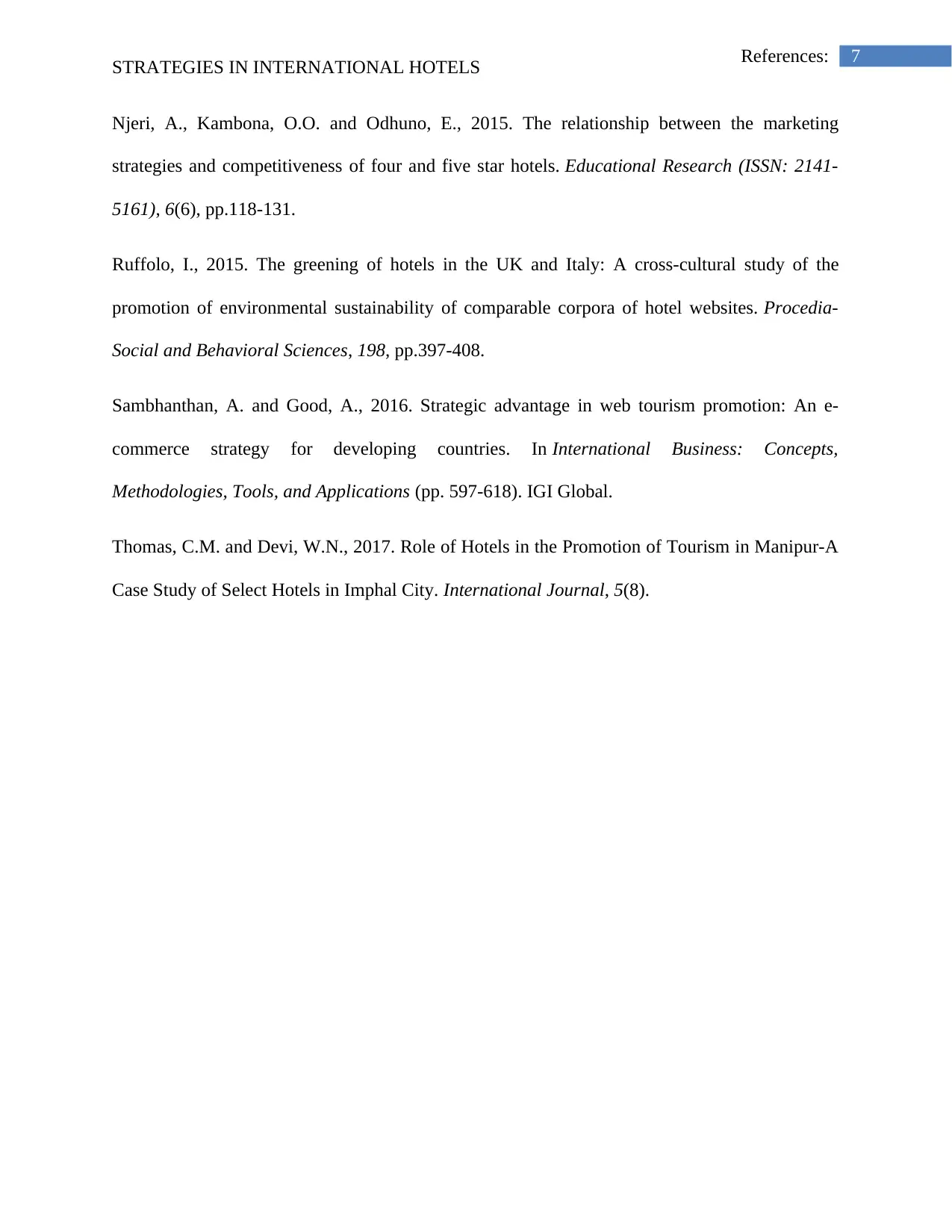
7References:
STRATEGIES IN INTERNATIONAL HOTELS
Njeri, A., Kambona, O.O. and Odhuno, E., 2015. The relationship between the marketing
strategies and competitiveness of four and five star hotels. Educational Research (ISSN: 2141-
5161), 6(6), pp.118-131.
Ruffolo, I., 2015. The greening of hotels in the UK and Italy: A cross-cultural study of the
promotion of environmental sustainability of comparable corpora of hotel websites. Procedia-
Social and Behavioral Sciences, 198, pp.397-408.
Sambhanthan, A. and Good, A., 2016. Strategic advantage in web tourism promotion: An e-
commerce strategy for developing countries. In International Business: Concepts,
Methodologies, Tools, and Applications (pp. 597-618). IGI Global.
Thomas, C.M. and Devi, W.N., 2017. Role of Hotels in the Promotion of Tourism in Manipur-A
Case Study of Select Hotels in Imphal City. International Journal, 5(8).
STRATEGIES IN INTERNATIONAL HOTELS
Njeri, A., Kambona, O.O. and Odhuno, E., 2015. The relationship between the marketing
strategies and competitiveness of four and five star hotels. Educational Research (ISSN: 2141-
5161), 6(6), pp.118-131.
Ruffolo, I., 2015. The greening of hotels in the UK and Italy: A cross-cultural study of the
promotion of environmental sustainability of comparable corpora of hotel websites. Procedia-
Social and Behavioral Sciences, 198, pp.397-408.
Sambhanthan, A. and Good, A., 2016. Strategic advantage in web tourism promotion: An e-
commerce strategy for developing countries. In International Business: Concepts,
Methodologies, Tools, and Applications (pp. 597-618). IGI Global.
Thomas, C.M. and Devi, W.N., 2017. Role of Hotels in the Promotion of Tourism in Manipur-A
Case Study of Select Hotels in Imphal City. International Journal, 5(8).
1 out of 8
Related Documents
Your All-in-One AI-Powered Toolkit for Academic Success.
+13062052269
info@desklib.com
Available 24*7 on WhatsApp / Email
![[object Object]](/_next/static/media/star-bottom.7253800d.svg)
Unlock your academic potential
© 2024 | Zucol Services PVT LTD | All rights reserved.





